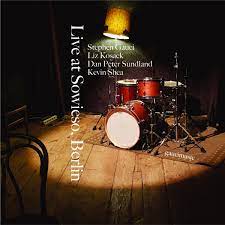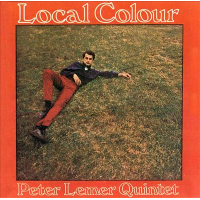
Daily Dose Of Jazz…
Dan Peter Sundland was born in Oslo, Norway on July 15, 1986 and grew up in Børsa, a village outside Trondheim, Norway. He started playing bass at age 14 and studied with bass players Andreas Bergsland and Mattis Kleppen. He was a member of Middle-Norwegian Youth Big Band and went on to become a member of the S. Møller big band.
Attending Sund Folk College from 2005 to 2006 he then attained a bachelor’s degree in jazz performance at NTNU Music Institute in Trondheim in 2010. He went on to get his European Jazz Masters degree (EUJAM) at NTNU Music Institute with exchange to Berlin Jazz Institute in 2012 and Rytmisk Musikkonservatorium in Copenhagen, Denmark in 2013.
Active in the jazz and improvisation scenes in Norway and Berlin, Germany he has set himself apart by his expressive, wide ranging playing techniques, including cello-like bowing and a varied palette of percussive colours. Has been featured with musicians including Jim Black, John Hollenbeck, Axel Dörner, Tobias Delius, Hans Hulbækmo, Hanna Paulsberg, Eirik Hegdal, John Pål Inderberg and Tor Haugerud.
His discography includes compositional work for his own eleven-piece Elevenette, the Berlin based improvising quartet Home Stretch and sideman work and collective groups including Lina Allemano’s Ohrenschmaus, Simon Kanzler’s hardcore opera and singer-songwriter Port Almond.
Electric bassist and composer Dan Peter Sundland, who has led Trondheim Improvisation Orchestra together with Peder Simonsen, continues to compose, perform and record.
More Posts: bandleader,bass,composer,history,instrumental,jazz,music

Daily Dose Of Jazz…
Luciano Troja was born in Messina, Italy on July 6, 1963. Self-taught from the age of 6, he studied for several years with the pianist-composer Salvatore Bonafede. In New York City, for a brief and intensive time, he studied with Richie Beirach. He attended several jazz courses and clinics such as Siena Jazz, Berklee Clinics in Umbria, Aebersold School in London, and piano courses with Shirley Scott, James Williams and Franco D’Andrea.
Luciano has performed at festivals and jazz clubs in Europe and the United States. He is the pianist of the Mahanada Quartet, an original combination of free improvisation and written music. He released three CDs with Mahanada that garnered extremely good reviews and recognitions. He released two CDs in duo with the guitarist Giancarlo Mazzù, Seven Tales About Standards and Seven Tales About Standards Vol. 2, both considered as a creative and original approach to the standards.
He along with Salvatore Bonafede of Double Piano Orchestra have recorded Double Rainbow and My Funny Valentine (Wide Sound, 2008).
He has been named Talent of the Year, Pianist of the Year, Group of the Year and CD of the Year in Top Jazz Poll of Musica Jazz magazine. He has since released At Home With Zindars a piano solo project. Pianist Luciano Troja continues to perform and record.
More Posts: bandleader,history,instrumental,jazz,music,piano

Daily Dose Of Jazz…
Jaimie Breezy Branch was born June 17, 1983 in Huntington, New York and started playing trumpet at age nine. At 14 she moved to Wilmette, Illinois, a suburb of Chicago. She attended the New England Conservatory of Music and after graduating moved back to Chicago and began working as a musician, organizer, and sound engineer on the local music scene. She performed in Chicago and New York with her trio Princess Princess, with bassist Toby Summerfield and drummer Frank Rosaly, and in other trios before founding the band Block and Tackle with Jason Stein, Jeb Bishop, and Jason Roebke.
By 2012 Branch had moved to Baltimore, Maryland where she worked toward a master’s degree in Jazz performance from Towson University. At this time she also founded the record label Pionic Records, which released the music of her group Bomb Shelter. After two years, she dropped out of Towson, and six months later she moved to New York to seek treatment for heroin addiction.
In 2015 Jaimie moved to Brooklyn, New York where she began working with Fred Lonberg-Holm, Mike Pride, Luke Stewart, Jason Nazary, Tcheser Holmes, and many more. In addition, she performed on albums with independent rock groups. In 2017 she released her debut solo album, Fly or Die, with Tomeka Reid, Jason Ajemian, Chad Taylor, Matt Schneider, Ben LaMar Gay, and Josh Berman. Fly or Die was chosen as one of NPR Music’s Top 50 Albums of 2017.
Citing Don Cherry, Axel Dörner, Booker Little, Miles Davis, and Evan Parker among her musical influences. Jaimie Branch transitioned at home in the Red Hook section of Brooklyn on August 22, 2022, at the age of 39.
More Posts: bandleader,history,instrumental,jazz,music,trumpet

Daily Dose Of Jazz…
Lou Gare was born Leslie Arthur Gare on June 16, 1939 in Rugby, Warwickshire, England. He is best known for his works with the improvised music ensemble AMM and recorded six albums with the group and another two as a soloist.
Eventually settling in the West Country, he still played in relative obscurity. Then Lou joined a big band that became The Uncommon Orchestra. He remained with them until health problems limited his participation.
Throughout his career he played with musicians such as Eddie Prévost, Mike Westbrook, Cornelius Cardew, Keith Rowe and Sam Richards
Free-jazz tenor saxophonist Lou Gare transitioned on October 6, 2017.
More Posts: history,instrumental,jazz,music,saxophone

Daily Dose Of Jazz…
Peter Naphtali Lemer was born June 14, 1942 in London, England and studied piano and composition at the Royal Academy of Music with Sven Weber and John Gardner, privately with Thomas Rajna, and then at workshops in London run by Jack Goldzweig. He then went to New York to study double bass with David Walter, attended workshops run by Bill Dixon, and studied piano with Jaki Byard and Paul Bley.
In 1965, Lemer formed a trio with John Stevens and Jeff Clyne, which opened the Little Theatre Club. In 1966, he formed the Peter Lemer Quintet, with drummer Jon Hiseman, tenor saxophonist George Khan, baritone saxophonist John Surman and bassist Tony Reeves. They successfully played a season at Ronnie Scott’s that helped to pave the way for the British free jazz movement of the late 1960s and early 1970s.
In 1969 Peter delved into experimental jazz with the group Spontaneous Music Ensemble,then joined Barbara Thompson that developed into Thompson forming Paraphernalia with husband Jon Hiseman. Paraphernalia became the most frequently performing jazz-oriented group in Europe. By 1974 he joined Gilgamesh, then became an in-demand session player and became a member of rock band Ken Elliot’s Seventh Wave.
The following year he joined Ginger Baker, Mr Snips, and The Gurvitz brothers in the Baker Gurvitz Army. His next move was with Jan Dukes de Grey briefly and then on to Mike Oldfield’s fifty-piece touring band as one of two keyboard players. Most recently Lemer has worked with the band In Cahoots, recording with them as well as with Paraphernalia.
Pianist and keyboardist Peter Lemer currently plays with the Spanish Harlow Orchestra and coaches piano, improvisation, and music technology. He is active in lobbying to end global hunger and poverty.
More Posts: bandleader,history,instrumental,jazz,keyboard,music,piano



